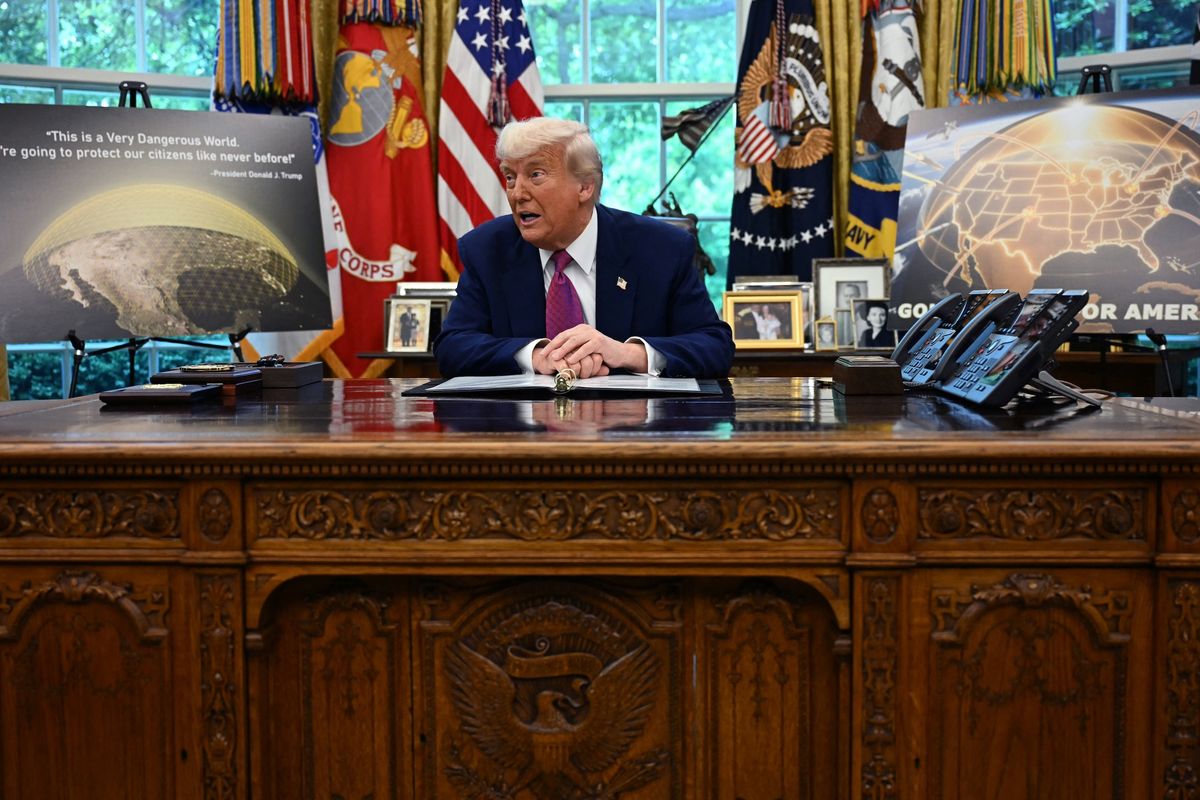When SpaceX successfully launched the National Reconnaissance Office's NROL-76 into orbit last month from the Kennedy Space Center in Florida and recovered the rocket's first stage, it marked the commercial space launch company’s first successful delivery in a series of top secret satellite launch contracts for the U.S. Air Force. These contracts had previously been limited to United Launch Alliance, the only certified provider for such classified launches until SpaceX received its certification in 2015.
It may also mark a turning point in the economics of space launch for both civilian purposes and defense. Companies such as SpaceX, Blue Origin, Orbital ATK, and others have rapidly reduced the cost of space launch in recent years, both through technological innovation - like the reusable rocket - and by introducing new competition into a relatively staid market.
The Cipher Brief’s Fritz Lodge spoke with former Secretary of the Air Force, Deborah Lee James, about this cost revolution in space launch and what opportunities it offers U.S. military space planners.
The Cipher Brief: How do you see commercial companies disrupting space launch for defense, especially after the recent SpaceX launch of a classified National Reconnaissance Office satellite?
Deborah Lee James: I think we’re truly in the midst of a real renaissance in space technology, it is a disruptive period and disruptive for the better.
There are a number of ways that private companies are disrupting the cost-equation, but the two most significant factors are, first, technological innovations from the private sector that are driving cost reduction and also enabling the government to adopt new business models. Second, is the reintroduction of competition to the launch market. On that one, I will credit not only the private sector but the government’s desire to reintroduce that competition.
When I talk about technological innovations, I’m thinking about things like advances in material science and sophisticated design software that ultimately enable weight reduction in key components. That reduced weight opens up a world of new possibilities in space launch. There are also techniques like additive manufacturing, where materials have been improved to the point where we can place very high temperature exposure and pressure conditions for things like a rocket nozzle. These components are very difficult to manufacture, but now we can increasingly 3D print them, which once again opens up new worlds. There is also the advent of increased computational power, which enables more realistic modeling of flight dynamics so that we can identify and eliminate potential failure points before you get into the stage of very expensive flight testing. These are just some of the technological innovations that are helping to drive down costs.
When it comes to the reintroduction of competition into the launch market, that is a major accomplishment. SpaceX has made much of this possible. For years, we only had one certified provider for national security launches, which was the United Launch Alliance, but now we have two certified providers for certain categories of our space launch. The fact that we have that competition has driven down costs, and I think it will also spur innovation for the future.
TCB: Can you talk a bit about this certification process? How did SpaceX become a certified provider for these launch categories?
James: The point of the certification process is that, when we’re talking about launching billion dollar satellites, it’s very important we have enough data to convince ourselves – “us” being the government – that it will be done in a reliable fashion, so that we don’t possibly lose a billion-dollar satellite in a space launch. Having high standards and quality control is something that is very important to the department of defense in this regard.
A new entrant like SpaceX had to go through a process to demonstrate that we could have that reliability and confidence in them. SpaceX was also heavily engaged in working with the government to negotiate what that process would look like specifically. It involved demonstrating a certain number of launches, it involved sharing a lot of engineering background material on their thinking and approach. Different companies who may seek to go through a similar certification process will also need to demonstrate some degree of actual launch capability and share their data and capabilities with the government so that we can understand the background of how they get to their solutions.
It can be different for each company. One company might wish to demonstrate more actual launches and share less of the engineering data. Another company may choose to share more of the data and do fewer launches. There’s no one-size-fits-all, but it is a combination between these two factors.
In my opinion, going through this process with SpaceX was our first time doing this in many years, and it took too long. As Secretary of the Air Force, I took measures to study why it took so long and looked at ways to speed it up.
It’s my hope that the next new entrant who goes through this certification will not have as lengthy a process, because all parties learn after going through this the first time, the second time ought to be a better, repeatable process.
TCB: What do you think is the most important opportunity offered to U.S. national security and defense architectures in space by dropping launch costs?
James: First of all, I would tell you that if current trends continue, we can expect that launch costs for the intermediate and medium-class vehicles will probably end up being about half the cost of launch before the reintroduction of competition. Half. That’s a really great deal for the government. The advent of reusable rockets is another huge game changer in terms of technological innovation and, taking all these things together, we hope that these costs can be driven down even more.
I caveat that by saying there are still heavy-class launch vehicles, which carry some of the largest U.S. government payloads. The government makes up the majority, if not all, of the heavy lift market – whereas commercial satellites form part of the intermediate lift market. If the government is the sole market for heavy lift launches, the costs for those systems will probably remain pretty high. I would like to believe that technological innovations will still bring these costs down somewhat but they’re never going to be at the same level as the intermediate class.
In addition to just flat out saving money, I think another benefit of this is, as the costs to launch go down, that frees up money you could apply to other important space requirements, like improving the resiliency of our space architecture. How do you protect against a war on earth extending into space? Maybe one way to improve resiliency is to build a larger constellation of satellites, which would complicate an adversary’s attack. A larger constellation could mean more launches but maybe we can afford that if the cost of launch is lower.
TCB: Speaking of a war on earth coming to space, what are the biggest threats and areas of our defense space architecture that we need to improve the most?
James: We have some very important capabilities that depend very heavily upon space. We depend upon space very heavily for missile warnings – every time that Kim Jong-un launches a ballistic missile, it is our space assets that enable us to detect those launches. All types of communication and all types of navigation and precision targeting – the GPS system – also depend heavily on space.
There are a lot of important capabilities that we need to protect and there are a lot of ways to do that. First of all, as new satellites are launched, they can be created in more resilient ways right from the get-go. This can mean anything from an ability to maneuver in different ways, it can be hardening the communications between earth and satellites so they can’t be jammed, there could be the use of alternative orbits so the location of the satellite is not as predictable. And of course, larger constellations help greatly in developing resiliency because it gives the adversary more targets to disable.
All of these strategies are either in process or being studied so that the right approach is taken.
TCB: If we can launch at low cost, others can too. Is there a new space race occurring and how does that change the threat and the way that we need to think about space defense?
James: I call it more of a Space Renaissance. All of these new technologies and techniques can be used for the benefit of mankind or, if used for ill purposes, they can be harmful. It’s the job of the U.S. military to be prepared to pivot and react.
Of course, we’re not sitting on our hands. I have left government now, but I know the team, and they are looking at all the possible threats out there and taking action.
TCB: How can policymakers best adapt to this space renaissance and take advantage of the new opportunities it provides?
James: I think every Secretary of the Air Force tries to do their best, during the time that they are privileged to serve, to take a look at the acquisitions system and ask how we can speed up our authorities and capabilities.
For me, I started an initiative called “Bending the Cost Curve,” which called for test programs, new approaches, and in some cases just accessing authorities that we hadn’t accessed either aggressively or at all in the past. The goal was to speed up the process for acquisition and driving down costs.
One of the poorly accessed authorities that we already had in our toolbox is called the Other Transaction Authority. This contracting vehicle is a way that you can get companies under contract to do certain types of work more quickly than the more typical RFP (Request for Procurement). During my tenure, we set one up for the cyber world, and we set a second one up to test out the new concepts in space. We set that second one up targeted at space within the final month before I left office, and this is not something that would manufacture the next billion-dollar satellite for us, but it is something where new concepts could be tested out, and things could be done more quickly.
Another way is to use the Alternate Acquisition Authority. This is an authority, which the Secretary of Defense could grant to the Air Force, that would help in the case of new programs that have not yet reached their first milestone. What that would do is allow us to move more quickly, it allows the Air Force to manage rather than have the final approval come from the Office of the Secretary of Defense. That just takes down a whole level of bureaucracy and allows you to move more quickly for new programs.
The third recommendation I would have to speed things up is to put at least some additional parts of the space program under the Rapid Capabilities Office. The RCO in the Air Force does have streamlined authority that would allow you to move more quickly.
Those are three ideas that I had and began to implement before I left office. I would recommend they continue to be pursued.












